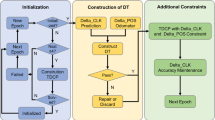Abstract
To improve multi-sensor passive localization precision, the optimal allocation form of multi-sensor bearing-only localization is analyzed from the perspective of the geometric dilution of precision (GDOP) of the least squares (LS) algorithm. This paper indicates that whether the target lies inside the closed region formed by the sensors or not, the optimal allocation is when each adjacent cut angle between a sensor pair is identical, and all sensors are located on the border of the circle that has the target (which is also the origin of the coordinate system) as its center. When there is no restriction on the adjacent cut angle in the above allocation, the optimal estimate of the LS algorithm in the sense of minimum variance can be acquired. When the LS algorithm achieves the optimal estimate and the sensors present the optimal allocation, the respective consistencies are analyzed. Simulation results verify the analysis of the optimal allocation form above, which can be used in multi-sensor passive localization algorithms based on sensor management.
Similar content being viewed by others
References
Smith D, Singh S. Approaches to multisensor data fusion in target tracking: A survey. IEEE Trans Knowl Data Eng, 2006, 18: 1696–1710
Chong C Y, Mori S, Chang K C, et al. Architectures algorithms for track association and fusion. IEEE Trans Aerosp Electron Syst, 2000, 15: 5–13
Wang D, Zhang L, Wu Y. The structured total least squares algorithm research for passive location based on angle information. Sci China Ser F-Inf Sci, 2009, 52: 1043–1054
Sun Z K, Zhou Y Y, He L X. Active/Passive Location Technology Based on Monostatic/Multistatic (in Chinese). Beijing: National Defense Industry Press, 1996
He Y, Xiu J J, Zhang J W, et al. Radar Data Processing with Applications (in Chinese). Beijing: Publishing House of Electronics Industry, 2009
Li W C, Wei P, Xiao X C. A robust TDOA passive location method and its performance analysis. Sci China Ser F-Inf Sci, 2009, 52: 876–882
Wang J G, Luo J Q. Passive tracking based on data association with information fusion of multi-feature and multi-target (in Chinese). Acta Electron Sin, 2004, 32: 1013–1016
Cao Z W, Zhao J, Gao B J. The research of location about the infrared multi-sites system based on the weighted least square method (in Chinese). Acta Photon Sin, 2005, 34: 1001–1004
Lui K W K, Chan F K W, So H C. Accurate time delay estimation based passive localization. Signal Process, 2009, 89: 1835–1838
Ho K C, Vicente L M. Sensor allocation for source localization with decoupled range and bearing estimation. IEEE Trans Signal Process, 2008, 56: 5773–5789
Xiu J J, He Y, Wang G H, et al. Constellation of multisensors in bearing-only location system. IEE Proc Radar Sonar Navig, 2005, 152: 215–218
Wang G H, Bai J, He Y, et al. Optimal deployment of multiple passive sensors in the sense of minimum concentration ellipse. IET Radar Sonar Navig, 2009, 3: 8–17
Levanon N. Lowest GDOP in 2-D scenarios. IEE Proc Radar Sonar Navig, 2000, 147: 149–155
Ge J J. Sensor network and its target geometric positioning method (in Chinese). Radar Sci & Technol, 2009, 7: 81–84
Jia X Q. Continuous-Wave Radar Data Processing (in Chinese). Beijing: National Defense Industry Press, 2005
Zhang X D. Matrix Analysis and Applications (in Chinese). Beijing: Tsinghua University Press, 2004
Sadaphal V P, Jain B. Localization accuracy and threshold network density for tracking sensor networks. ICPWC, 2005. 408–412
Author information
Authors and Affiliations
Corresponding author
Rights and permissions
About this article
Cite this article
Wang, B., He, Y., Wang, G. et al. Optimal allocation of multi-sensor passive localization. Sci. China Inf. Sci. 53, 2514–2526 (2010). https://doi.org/10.1007/s11432-010-4124-4
Received:
Accepted:
Published:
Issue Date:
DOI: https://doi.org/10.1007/s11432-010-4124-4




